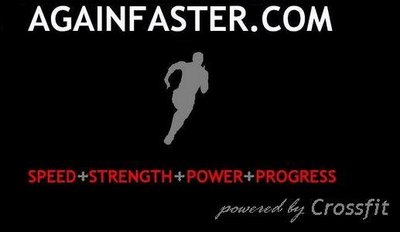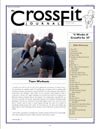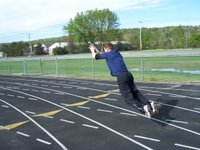Principles of Speed

“The Athlete’s Mission Statement: Generate and apply the greatest amount of force over the greatest range of motion in the least amount of time.”—Dave Kerin, Middlebury College Track & Field
I attended the USATF Coaching Certification for one reason: Crossfitters sprint constantly, and no one seems to get much faster.
Sprinting is not jogging with a higher stride rate. If you ask an athlete with a background in high-mileage running to sprint, their mechanics will remain the same regardless of speed. They will go faster, but the improvement is asymptotic. They’ll soon reach the ends of their ability, limited by form rather than potential.
Speed is not driven by rate of action. It is driven by force of action. Translated to sprinting, this means your speed is based on how much power you apply to the ground, rather than how fast you move your feet.
Most folks get this exactly backward. They assume a higher stride rate produces speed. Rather, a higher rate of force production produces speed. This truism is based on Newton’s Third Law: For each action, there is an equal and opposite reaction. The more force we put into the ground, the more force it returns to propel us forward. This process is observable as increased stride length—a more powerful foot strike propels the athlete further than a less-powerful foot strike.
Good sprint mechanics start with posture. The body must be relaxed and in balance. The head is aligned with the spine, and the shoulders are aligned with the hips.

Notice that our sprinter is squared to the direction of travel—there is no angular rotation about the spine. This ensures that all of his energy is directed toward propelling him forward.
When the recovering foot hits the ground, it strikes directly under his center of mass. This prevents the braking action that would occur if his foot landed in front of him.

Upon contact, he achieves full hip extension, much like the second pull of the Olympic lifts. During this process, the foot is in full dorsiflexion. The toes are pulled toward the shin, creating a ninety-degree angle at the ankle. This creates a rigid unit with very little give, allowing a majority of the produced force to be transmitted to the ground. 30-50% of the landing energy is transferred to the next stride, preserving forward momentum.

At maximal velocity, the heels recover high. This means the recovering foot passes the lead leg above the knee and below the gluteus maximus.
The foot is then brought as high as possible in front of the athlete. This maximizes foot speed as the leg extends toward the ground, helping to create a powerful foot strike.
Our Instructors continually reminded us to think of the foot as a hammer, striking the ground as hard as possible. Sprint speed is all about force production and amplitude of movement.
Amplitude of movement refers to the vertical travel of the sprinter. With each foot strike and extension, the athlete launches off the ground, the hips traveling upward. As he transitions into the next stride, the hips travel downward. If you were to trace the path of the hip during a sprint, it would look very similar to a sine wave. This oscillation is indicative of good force production.
According to Dan Laufer of the University of Virginia, many athletes lose amplitude of movement when they try to run faster. This is a symptom of rigidity in the hips and overall body tension. Again, relaxation is paramount to speed, and a large range of motion in the hips is necessary for optimal performance.
I plan on applying these principles to the athletes at Again Faster and Crossfit Boston yesterday. No longer will fast jogging suffice when sprinting is called for. We’ll be working on good posture, high knee lift, dorsiflexion, hip extension, and a large range of motion until everyone stops trying to run a mini-marathon when the WOD calls for a 400 meter sprint.
It’s time to go faster.
Picture of Michael Johnson, holder of five Olympic gold medals in the 200m, 400m, and 4x400m, courtesy of texassports.com. Pictures of J.J. Johnson at the 2002 Mt. Sac Relays courtesy of sprintic.com.

“The Athlete’s Mission Statement: Generate and apply the greatest amount of force over the greatest range of motion in the least amount of time.”—Dave Kerin, Middlebury College Track & Field
I attended the USATF Coaching Certification for one reason: Crossfitters sprint constantly, and no one seems to get much faster.
Sprinting is not jogging with a higher stride rate. If you ask an athlete with a background in high-mileage running to sprint, their mechanics will remain the same regardless of speed. They will go faster, but the improvement is asymptotic. They’ll soon reach the ends of their ability, limited by form rather than potential.
Speed is not driven by rate of action. It is driven by force of action. Translated to sprinting, this means your speed is based on how much power you apply to the ground, rather than how fast you move your feet.
Most folks get this exactly backward. They assume a higher stride rate produces speed. Rather, a higher rate of force production produces speed. This truism is based on Newton’s Third Law: For each action, there is an equal and opposite reaction. The more force we put into the ground, the more force it returns to propel us forward. This process is observable as increased stride length—a more powerful foot strike propels the athlete further than a less-powerful foot strike.
Good sprint mechanics start with posture. The body must be relaxed and in balance. The head is aligned with the spine, and the shoulders are aligned with the hips.

Notice that our sprinter is squared to the direction of travel—there is no angular rotation about the spine. This ensures that all of his energy is directed toward propelling him forward.
When the recovering foot hits the ground, it strikes directly under his center of mass. This prevents the braking action that would occur if his foot landed in front of him.

Upon contact, he achieves full hip extension, much like the second pull of the Olympic lifts. During this process, the foot is in full dorsiflexion. The toes are pulled toward the shin, creating a ninety-degree angle at the ankle. This creates a rigid unit with very little give, allowing a majority of the produced force to be transmitted to the ground. 30-50% of the landing energy is transferred to the next stride, preserving forward momentum.

At maximal velocity, the heels recover high. This means the recovering foot passes the lead leg above the knee and below the gluteus maximus.
The foot is then brought as high as possible in front of the athlete. This maximizes foot speed as the leg extends toward the ground, helping to create a powerful foot strike.
Our Instructors continually reminded us to think of the foot as a hammer, striking the ground as hard as possible. Sprint speed is all about force production and amplitude of movement.
Amplitude of movement refers to the vertical travel of the sprinter. With each foot strike and extension, the athlete launches off the ground, the hips traveling upward. As he transitions into the next stride, the hips travel downward. If you were to trace the path of the hip during a sprint, it would look very similar to a sine wave. This oscillation is indicative of good force production.
According to Dan Laufer of the University of Virginia, many athletes lose amplitude of movement when they try to run faster. This is a symptom of rigidity in the hips and overall body tension. Again, relaxation is paramount to speed, and a large range of motion in the hips is necessary for optimal performance.
I plan on applying these principles to the athletes at Again Faster and Crossfit Boston yesterday. No longer will fast jogging suffice when sprinting is called for. We’ll be working on good posture, high knee lift, dorsiflexion, hip extension, and a large range of motion until everyone stops trying to run a mini-marathon when the WOD calls for a 400 meter sprint.
It’s time to go faster.
Picture of Michael Johnson, holder of five Olympic gold medals in the 200m, 400m, and 4x400m, courtesy of texassports.com. Pictures of J.J. Johnson at the 2002 Mt. Sac Relays courtesy of sprintic.com.




















2 Comments:
Sounds like it was a great clinic. Where'd you hear about it as the site doesn't show much for their clinics....
QUESTION:
You state, "The more force we put into the ground, the more force it returns to propel us forward. This process is observable as increased stride length—a more powerful foot strike propels the athlete further than a less-powerful foot strike."
I understand and agree, but for the non/limited-runner, it translates to an up-down movement versus a forward propulsion. Any cues or verbalizations to help rewire the thinking?
=======
You doing the CF level2 in Michigan?
John,
The USATF clinics are not clinics, but rather "Coach's Education". You'll find them under an eponymous link on the USATF site.
The powerful foot strike will lead to up and down movement (amplitude), which is actually desirable. The upward vector is tempered by the forward travel of the hips, caused by the rear leg coming forward to assume the front position.
Rather than advise your athletes to strike the ground hard, tell them to "catch" the ground and push it away as hard as possible. If they have any momentum at all, the direction of travel will be forward.
The one thing I did neglect--acceleration mechanics. The shorthand coaching technique: Look at the shin angle. It should start at 45 and move to vertical over the course of 20-30 meters. It will be a gradual progression. Heel recovery should be low, i.e. the rear foot passes the front leg fairly close to the ground, allowing the athlete to spend more time in contact with the ground. As he/she reaches maximal velocity, this changes to high heel recovery.
I'm probably not going to go to MI. Next time I go anywhere, I'm thinking CA for Cert Purposes. I want to try and hit a USA Weightlifting Club Coach Course at the same time!
Best,
Jon
Post a Comment
<< Home